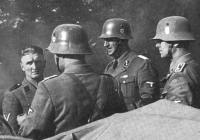 |
| SD Men |
Einsatzgruppen (Special Task Forces) were mobile killing units that operated in German-occupied
Europe. Members came from the SS (
Schutzstaffel), SD (
Sicherheitsdienst / Security
Service of the SS), Sipo (
Sicherheitspolizei / Security Police) and the Orpo (
Ordnungspolizei /
Order Police).
They first appeared during the
Anschluss (unification with Austria), reappearing on the invasion of
Czechoslovakia. In both of these countries they served as mobile offices of the SD and Sipo, responsible
for the security of the regime. But it was with the invasion of Poland that the activities of the
Einsatzgruppen
escalated from occasional to wholesale murder.
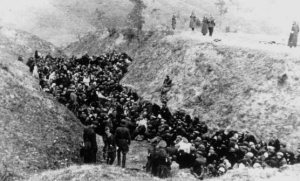 |
| A killing site |
By an agreement between the military and the SS of
31 July 1939, the task of the
Einsatzgruppen (EG) in Poland was defined as the "combating of all anti-German elements in hostile
country behind the troops in combat."
Initially
5 Einsatzkommandos were formed, subsequently increased by the
addition of two further
Einsatzgruppen and a separate
Einsatzkommando from
Gdansk (Danzig). In total they numbered some 3,000 men.
Many of the leaders were representative of the intellectual elite of the Nazi party. Of the
25
Einsatzgruppen and
Einsatzkommando leaders, 15 of them bore the title of PhD, most
of them doctors of jurisprudence or philosophy. Their task was the elimination of Polish political
opponents and Jews. In theory, the army exercised control of the
conquered territories, being permitted to not only use force against armed resistance,
strikes and sabotage, but also to arraign irregulars and spies before a court-martial and sentence
them to death. However, this did not satisfy
Reinhardt Heydrich.
Although 200 executions were occurring daily, he complained that the
courts-martial were much too slow:
"
The people must be shot or hanged immediately without trial. The little people
we want to spare, but the nobles, priests, and Jews must be killed."
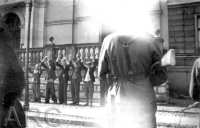 |
| Bydgoszcz |
In the first weeks of the Polish campaign the
Einsatzgruppen carried out more than 10,000 arrests.
On
3 September 1939
Heinrich Himmler ordered them to shoot all insurgents,
defined as anyone who endangered German life or property. Innumerable atrocities occurred. In
Bydgoszcz (Bromberg), where killings of
Volksdeutsche by Poles
had occurred in the first days of the war, mass shootings were carried out by police,
Einsatzgruppen
and troops. By
10 September, 340 - 540 Polish civilians had been shot in
the town. In other incidents, Jewish victims became increasingly prominent. On
20 September the 14th Army reported mass shootings, especially
of Jews by the "
Einsatzgruppe Woyrsch".
The same day the
Einsatzgruppen were disbanded and their personnel absorbed by
the permanent SD and Sipo in Poland. By that time about
15,000 persons had been killed. Infinitely worse bloodshed would take place following the attack on the Soviet Union.
 |
| Questioning of Jews |
Following consultations that had taken place between
Heydrich and the army's
Generalquartiermeister Eduard Wagner in connection with the planning of
"Operation Barbarossa", General
Walter von Brauchitsch, commander in chief of
the army, issued an order stating that units of the SD would be responsible for "special security matters" in the
army's operational area. Although the
Einsatzgruppen would be operating on their own responsibility,
they would depend on the army for logistical support. The order concluded by stating that the special units were
empowered to carry out "executive measures against the civilian population."
During
May and June 1941, those assigned to the
Einsatzgruppen
gathered at the border police
training school at
Pretzsch in Saxony.
Heydrich and
Heinrich
Müller, head of the
Gestapo,
reportedly visited them on one or more occasions. The leaders of the
Einsatzgruppen received their
orders from either
Heydrich or
Bruno
Streckenbach, head of the personnel department of the
RSHA. Evidence was produced before the
Nürnberg Military Tribunal indicating that these orders included the killing of Soviet Jews.
Karl Jäger of EK3 recalled a meeting of about 50 SS leaders with
Heydrich in
Berlin, where
Heydrich declared that in the event of war with the Soviet Union, the Jews
in the east would have to be shot. A
Gestapo man asked: "We shall shoot the Jews?"
Heydrich replied: "Of course."
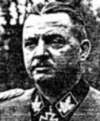 |
| B. Streckenbach |
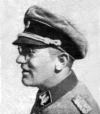 |
| F. W. Stahlecker |
Four
Einsatzgruppen were created, lettered A - D, and attached to Army Group North (EG A - 1,000 personnel
covering the Baltic States to
Leningrad), Centre (EG B - 655 Byelorussia to
Moscow), South (EG C - 700 northern and central Ukraine) and the 11th Army
(EG D - 600 - southernmost Ukraine and the Caucasus), respectively.
Each of the
Einsatzgruppen was divided into two or three
Sonderkommandos (SK) and
Einsatzkommandos (EK). In theory, the
Sonderkommandos operated in the army operational
areas whilst the
Einsatzkommandos were to function in the rear army areas. In practice, however, the
distinction disappeared. Both
Einsatzkommandos and
Sonderkommandos also had temporary
sub-units, usually referred to as
Teilkommandos (Part Detachments). When allocated to a specific city
or location they were called
Vorkommandos (Advance Detachments).
Vorkommando
Moskau, for example, was attached to
Einsatzgruppe B.
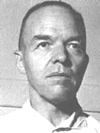 |
| Otto Rasch |
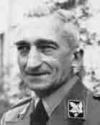 |
| Arthur Nebe |
As in Poland, the
Einsatzgruppen leaders and their subordinate officers were carefully selected by
Heydrich from among the best-educated and dedicated Nazis. Three of the four
commanders held doctorates;
Franz Walter Stahlecker (EG A),
Otto Rasch
(EG C a double PhD), and
Otto Ohlendorf (EG D).
The commander of
Einsatzgruppe B was
Arthur Nebe,
then head of the Kripo (
Kriminalpolizei Criminal Police). Of the 17 initial SK, EK, and
Vorkommando
leaders, a further 7 held a doctorate. Subsequent leaders included an ex-pastor
(
Ernst Szymanowski alias Biberstein), a physician
(
Weinmann), and a professional opera singer
(
Klingelhöfer). These were clearly no gangsters. They represented those who,
in a different time and a different culture, might have been considered among the brightest and the best of their
generation.
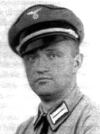 |
| Szymanowski |
On
22 June 1941, approximately 3 million German soldiers invaded the Soviet
Union. The four
Einsatzgruppen
followed close on their heels. Until that time, their instructions had all been given orally, and those instructions did
not explicitly include the extermination of
all Jews. On
2 July 1941
Heydrich
wrote to the Higher SS and Police Leaders (HSSPF) in the occupied Soviet territory setting out the verbal
instructions he had given to the
Einsatzgruppen. Regarding executions,
Heydrich wrote:
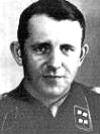 |
| Rudolf Lange |
"
All the following are to be executed:
Officials of the Comintern (together with professional Communist politicians in general; top and medium-level
officials and radical lower-level officials of the Party, Central Committee, and district and sub-district
committees; People's Commissars; Jews in Party and State employment, and other radical elements
(saboteurs, propagandists, snipers, assassins, inciters, etc.)... "
The list was of those to be executed immediately. However, it is considered very likely that the
Einsatzgruppen
leaders were aware that the longer-term future intention was the killing of Soviet Jews in toto. In
January 1942,
Rudolf Lange of EK 2 wrote:
"
The goal that Einsatzkommando 2 had in mind from the beginning was
a radical solution to the Jewish problem through the execution of all Jews."
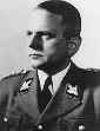 |
| Otto Ohlendorf |
Felix Landau was a member of an
Einsatzkommando, based first in
Lviv (Lwow) and then in
Drohobycz.
In
July 1941 he began to record his daily experiences in a diary, a mixture
of saccharin sentimentality and dispassionate brutality:
"
Lwow - 5 July 1941...
There were hundreds of Jews walking along the street with blood pouring down their faces,
holes in their heads, their hands broken and their eyes hanging
out of their sockets. They were covered in blood. Some were carrying
others who had collapsed. We went to the citadel; there we saw things that
few people have ever seen. At the entrance to the citadel there were
soldiers standing guard. They were holding clubs as thick as a man's
wrist and were lashing out and hitting anyone who crossed their path. The Jews were
pouring out of the entrance. There were rows of Jews lying one on top of the
other like pigs, whimpering horribly. The Jews kept streaming out of the citadel
completely covered in blood. We stopped and tried to see who was in charge of the Kommando.
Nobody. Someone had let the Jews go. They were just being hit out of rage and hatred...
Drohobycz - 12 July 1941...
At 6:00 in the morning I was suddenly awoken
from a deep sleep. Report for an execution. Fine, so I'll just play executioner
and then gravedigger, why not?... Twenty-three had to be shot, amongst them ...
two women ... We had to find a suitable spot to shoot and bury them. After a few minutes
we found a place. The death candidates assembled with shovels to dig their own graves.
Two of them were weeping. The others certainly have incredible courage... Strange, I am
completely unmoved. No pity, nothing. That's the way it is and then it's all over...
Valuables, watches and money are put into a pile... The two women are lined
up at one end of the grave ready to be shot first... As the women walked to the
grave they were completely composed. They turned around. Six of us had to shoot them.
The job was assigned thus: three at the heart, three at the head. I took the heart.
The shots were fired and the brains whizzed through the air. Two in the head
is too much. They almost tear it off..."
In practice, the
Einsatzgruppen found most of the political candidates for liquidation had fled. The
great majority of executions in the first five weeks of Barbarossa were therefore aimed at those who were
immediately accessible Jewish males, particularly those in leadership positions and members of the
intelligentsia. But
late July 1941, the killing escalated to include
all Jewish men, women and children. If
there had ever been any doubt about what Nazi policy was to be in the Soviet Union, during the course
of a conversation
Hitler had with
Göring,
Lammers, Rosenberg and
Keitel
on
16 July 1941, it was now made abundantly clear. Victory over the
Soviet Union was imminent. To create a "Garden of Eden" in the east, "all necessary measures
shootings, resettlements, etc." would be undertaken. It was fortunate that the Russians had
given the order for partisan warfare, for "it gives us the opportunity to exterminate anyone who
is hostile to us."
Hitler did not issue an explicit order
(he rarely did), but the intention was obvious. Within a week of this speech,
Himmler had more than quadrupled the number of SS men operating behind the
advancing German army. At least a further 11 battalions of Order Police were assigned to the HSSPF.
Local auxiliaries in
Selbstschutz battalions were recruited; they numbered 33,000 by the
end of 1941, 165,000 by
June 1942, and 300,000 by
January 1943.
If the task of killing Soviet Jewry with the 3,000 men of the
Einsatzgruppen had been impossible,
by the
end of July 1941, the manpower had become available for the execution
of the task. By the
end of 1941 between 500,000 and 800,000 Jews had been murdered
an average of 2,700 - 4,200 per day.
Communist officials, resistance fighters, POWs, Romany and especially Jews were killed throughout the
Soviet Union. The victims were rounded up and taken to secluded sites outside of cities, towns and villages.
There they were shot and buried in anti-tank ditches, quarries, gorges and other similar sites. The killers
mercilessly murdered men, women and children. The
Einsatzgruppen and their assistants ultimately
killed more than 1.2 million individuals. There were very few survivors of these massacres. Many of the killing
squad members drank vast quantities of alcohol to withstand the physical and psychological stress caused
by their inhuman and bestial duties. Others found it possible to rationalise their behaviour. In the
autumn of 1942,
Obersturmführer Karl
Kretschmer, serving with SK 4a (one responsible for the
Babi Jar massacre) wrote a series of letters to his wife and children:
"
... I am no longer in the area of Stalingrad
but further north in the middle of the front... The sight of the dead (including women and children) is not very
cheering. But we are fighting for the survival or non-survival of our people... As the war is in our opinion a
Jewish war, the Jews are the first to feel it. Here in Russia, wherever the German soldier is, no Jew remains.
You can imagine that at first I needed some time to get to grips with this... We happen to be in possession
of old clothes, which are very much sought after. We can get everything here. The clothes belonged to
people who are no longer alive today...
... We have got to be tough here or else we will lose the war. There is no room for pity of any kind...
There are no Jews here anymore...I have already told you about the shooting that I could not say 'no' here
either... We have to eat and drink well because of the nature of our work, as I have described to you in
detail. Otherwise we would crack up... If it weren't for the stupid thoughts about what we are doing in this
country, the Einsatz here would be wonderful, since it has put me in a position where I can
support you all very well. Since, as I already wrote to you, I consider the last Einsatz to be justified
and indeed approve of the consequences it had, the phrase 'stupid thoughts' is not strictly accurate.
Rather it is a weakness not to be able to stand the sight of dead people; the best way of overcoming it is to
do it more often. Then it becomes a habit..."
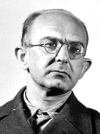 |
| Franz Six |
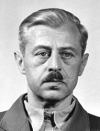 |
| Erwin Schulz |
It was a myth that refusal to participate in killings was impossible. Professor Dr
Franz Six, in charge of
Vorkommando
Moskau:
"
During the war a person could at least try to have himself transferred
from an Einsatzgruppe. I myself managed to do this successfully
I was not demoted as a
result of my transfer and not disadvantaged, apart from remaining on very bad terms with
Heydrich until his death. There were without doubt cases where people who
were transferred from an Einsatzgruppe suffered disadvantage. I can no longer recall
individual cases. None the less, as far as I know, nobody was shot as a result."
Similarly,
Erwin Schulz, head of
Einsatzkommando 5:
"
I do not know of or recall any order that stated that SS chiefs or
members of the SD or the police would be sent to concentration camps if they refused to carry
out an order. I also never heard of such an order during the course of conversations I had
on the subject or indeed from rumours."
There was no attempt to hide or disguise the killings. A
Wehrmacht officer, Major
Karl Rösler, stationed in
Zhytomyr,
reported on how he had witnessed an execution in the
summer of 1941. Hearing
rifle volleys and pistol shots
he had hurried towards a railroad embankment, accompanied by many soldiers and civilians. What he
saw was so "brutally base that those who approached unprepared were shaken and nauseated."
He stood above a ditch with a mound of earth on one side. The wall of the ditch was covered in blood.
Policemen were standing around with bloodstained uniforms, soldiers, some in bathing shorts, were
congregating in groups, and civilians were watching with their wives and children. The pit so was full
of corpses of all ages and sexes that it was not possible to estimate its depth.
Rösler concluded his report:
"
I have seen many unpleasant things, being a member of the Freikorps
in 1919, but I have never seen anything like this. I cannot begin to
conceive the legal basis on
which these executions were carried out. Everything that is happening here seems to be absolutely
incompatible with our views on education and morality. Right out in the open, as if on a stage, men
murder other men. I must add that, according to the accounts of the soldiers, who often see spectacles
of this kind, hundreds of people are killed in this way every day."
Very precise records of
Einsatzgruppen activities were maintained. The commanders were
required to send regular operational reports to
Heydrich in
Berlin.
Many of these reports have survived and provide a chilling catalogue of mass murder. The incoming reports
were edited at the RSHA, and distributed to other government agencies. It is known that copies were
produced in a suitable format for
Hitler's scrutiny.
Given the number of military and civilian eyewitnesses of massacres and the wide circulation of the reports,
there can be no doubt that the barbaric nature of
Einsatzgruppen operations were widely known.
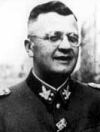 |
| v.d.Bach-Zelewski |
Shooting on this scale, particularly of women and children, was destroying the morale of the
Einsatzgruppen.
Some committed suicide, or were admitted to mental asylums. As
Erich von dem Bach-Zelewski allegedly said to
Himmler after the latter had witnessed a shooting action at
Minsk in
August 1941:
"
Such men are finished for the rest of their lives! What kind of followers
are we creating? Either neurotics or brutes."
As a consequence, it was decided to introduce
"
a new and better method of killing" better, that is, for the executioners,
not for the victims. The result was the
Gaswagen
(
gas vans). 15-20 of these had been delivered to
the
Einsatzgruppen
by
late June 1942. They were used by
Einsatzgruppe A in
Riga, and probably in Estonia, Latvia and the
Leningrad region.
Einsatzgruppe B utilised them in the
Minsk area. In the Ukraine,
Einsatzgruppe C took advantage of
the new method, as did
Einsatzgruppe D in the
Crimea and Caucasus. The transition from shooting to gas vans was not entirely successful, the use
of the latter being hardly less stressful for the
Einsatzgruppen than the butchery of the former.
It was time to move to a new killing phase, one that would involve bringing the victims to the executioners,
rather than transporting the killers to their prey. By the
late autumn or early winter of 1941,
Belzec had been surveyed as a prospective killing site, and the first
experiments with "Zyklon B" had been conducted at
Auschwitz. The rate of murder was set to increase exponentially in
1942.
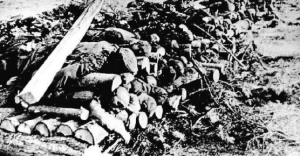 |
| Cremating the Corpses |
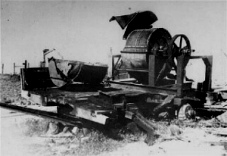 |
| Bone Crushing Machine |
There was now the problem of how to remove the evidence of the
Einsatzgruppen's crimes.
Special units
(
Sonderkommandos 1005) were activated. They had to exhume and cremate the
corpses throughout the
Einsatzgruppen's area of operations. Prisoners, mainly Jews, were
ordered to undertake this gruesome task. The bodies were stacked between logs of wood and petrol
poured over the pyres, which were then set alight. Workers used bone crushing machines or hammers
to destroy all that then remained and scattered the ashes or buried them in the pits from which the
corpses had been removed. When this was completed the workers were shot. A few of them managed
to escape, some surviving to describe their experiences.
In his masterpiece, 'Life and Fate',
Vasily Grossman
wrote an imaginary final letter from his mother. She had been a resident of
Berditchiv in the Ukraine, where
Sonderkommando 4a annihilated the
Jewish population of 30,000 in
September 1941. Although a work of fiction,
it provides some of the most eloquent victim testimony:
"
They say that children are our future, but how can one say that of these
children? They aren't going to become musicians, cobblers or tailors. Last night I saw very clearly
how this whole noisy world of bearded, anxious fathers and querulous grandmothers who bake
honey-cakes and goose-necks this whole world of marriage customs, proverbial sayings and
Sabbaths will disappear for ever under the earth. After the war life will begin to stir once again, but
we won't be here, we will have vanished just as the Aztecs once vanished.
The peasant who brought us the news about the mass graves said that his wife had been crying
at night. She'd been lamenting: 'They sew, and they make shoes, and they curry leather, and they
mend watches, and they sell medicines in the chemist's. What will we do when they have all been killed?'"
Einsatzgruppen did not operate solely in Austria, Czechoslovakia, Poland and the Soviet Union.
They were active in hunting and killing Jews in many of the other countries occupied by the Nazis, including
France, Hungary, Italy, Luxembourg, Greece, Serbia, and even Tunisia. After the war some
Einsatzgruppen
leaders were
tried in
Nürnberg. In addition,
proceedings were initiated against somewhat in excess of 100 former
Einsatzgruppen members
by West German courts. It is apparent that the great majority of the
Einsatzgruppen perpetrators
were neither indicted nor convicted.
Sources:
Hilberg, Raul.
The Destruction of the European Jews, Yale University Press, New Haven, 2003
Gutman, Israel, ed.
Encyclopedia of the Holocaust, Macmillan Publishing Company, New York, 1990
Arad, Yitzhak; Gutman, Israel and Margaliot, Abraham eds.
Documents On The Holocaust, University of
Nebraska Press, Lincoln and London, 1999
Klee, Ernst. Willi Dressen and Volker Riess .
The Good Old Days - The Holocaust as Seen by Its Perpetrators
and Bystanders, Konecky & Konecky, New York 1991
Kogon, Eugen; Langbein, Hermann and Rückerl, Adalbert ed.
Nazi Mass Murder - A Documentary History
of the Use of Poison Gas, Yale University Press, New Haven, 1993
Browning, Christopher R.
The Path to Genocide Essays on Launching the Final Solution,
Cambridge University Press, Cambridge, 1997
Browning, Christopher R.
The Origins of the Final Solution The Evolution of Nazi Jewish Policy
September 1939 March 1942, William Heinemann, London, 2004
Rhodes, Richard.
Masters of Death The SS-Einsatzgruppen and the Invention of the Holocaust,
Alfred A. Knopf, New York, 2002
Grossman, Vasily.
Life and Fate, The Harvill Press, London, 1995
Garrard, John and Garrard, Carol.
The Bones of Berdichev The Life and Fate of Vasily Grossman,
The Free Press, New York, 1996
© ARC 2005






















